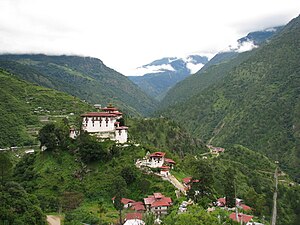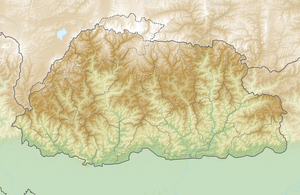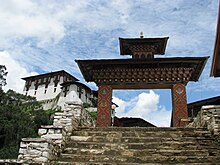Lhuentse Dzong
| Lhuentse Dzong | ||
|---|---|---|
| Alternative name (s): | Lhundrup-Rinchhentse-Dzong | |
| Creation time : | 1543 | |
| Castle type : | Dzong (monastery castle) | |
| Geographical location | 27 ° 39 '54 " N , 91 ° 11' 12" E | |
|
|
||
The Lhuentse-Dzong , also Lhundrup-Rinchhentse-Dzong , is a fortress and at the same time a Buddhist monastery in the Lhuntse district in eastern Bhutan . The Dzong is located on the east side of the Kuri Chhu on a mountain spur at the end of a narrow valley.
The monastery fortress was originally known as Kurtoe in the then secluded Lhuntse district. It is the ancestral seat of the House of Wangchuck , the royal family of Bhutan.
Although the Dzong is geographically located in eastern Bhutan, its cultural roots are in central Bhutan. This is due to the fact that, before the road link into Mongar district was established, access along the trade route was via the Rodang Pass .
topography

The Dzong is located in the Kuri Chhu Valley , which is part of the Lhuntse District. The Kuri Chhu is a larger river that has formed a scenic valley with steep hills and high mountain peaks. The Kuri Chhu is a tributary of the Manas , the largest river in Bhutan and an important tributary of the Brahmaputra , into which most of the rivers of Eastern Bhutan flow.
It is a three-hour drive to Lhuentse Dzong on the Mongar road over a distance of 77 km, 63 km from the junction at Gangola . Access to the dzong is via a flagstone path over steep cliffs.
history
According to a legend, Khedrup Kuenga Wangpo , son of Tertön Pema Lingpa , was tasked with finding a ridge whose shape should be reminiscent of an elephant's trunk. He found one across from Baeyul Khenpajong and mediated there. This place became known as Kurtoe Lhuentse Phodrong.
The monastery was originally founded in 1543 by Pema Lingpa's son Kunga Wanpo , although it was not until 1654 that the Trongsa Penlop Minjur Tenpa - after winning a battle - turned it into a monastery fortress and named it Lhuentse Rinchentse .
The dzong was restored in 1962 and again between 1972 and 1974. The Lhuentse Dzong (khag) is historically significant as the ancestral seat of the Wangchuck dynasty. The city of Lhuentse is next to the Lhuentse-Dzong administrative seat of the district Lhuentse. About 100 monks live there.
architecture
The dzong houses five temples, three of which are in the central tower and are dedicated to Padmasambhava . The dzong also contains a gonkhang dedicated to Mahakala and a temple in honor of Amitabha , the Buddha of infinite life. There is a temple dedicated to Avalokiteshvara on the ground floor of the dzong . The Kunre , the meeting hall of the monks, is on the upper floor.
The Dzong suffered severe damage in a magnitude 6.1 earthquake on the Richter scale that struck eastern Bhutan on September 21, 2009. A number of other monasteries in the region also suffered severe damage.
literature
- Françoise Pommaret: Bhutan . Edition Earth • Travel Guide. 11th edition. Edition Temmen, Bremen 2013, ISBN 978-3-86108-810-3 , pp. 209 .


